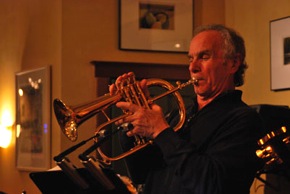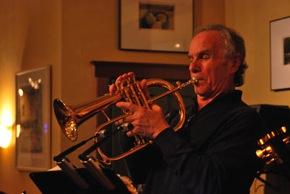
Featured Video
Buy Tickets
Guarneri Double Quartet
Venue: Healdsburg Center for the ArtsCity: Healdsburg
Date: February 23, 2011 7:00pm
Price Range: $25 per person
Mario Guarneri, despite his surname and his professional credentials, is no more a classical purist than he is a violinist. Instead, the 68-year-old Juilliard-trained trumpeter, who spent 15 years with the Los Angeles Philharmonic, is a proponent of both the jazz and classical repertoires, as he’ll demonstrate with his Feb. 23 benefit appearance for the Healdsburg Jazz Festival. And he preaches what he practices, as a faculty member at the San Francisco Conservatory.
Both of Guarneri’s offerings at the Conservatory help classical students make their way through modern times. He teaches Improvisation as “a free improv class, but not a jazz class, to get the kids to pull stuff out of their heads,” explains Guarneri, who lives in Fairfax. “And the ones who are brave enough to take the class, once they get in, it’s very safe. They don’t realize it, but they already have it within themselves.”
Then there’s the curiously titled Practical Aspects of Music class, “which is how to get a gig. We talk a lot about marketing and collaboration, and it’s really exciting! When they asked me to teach it, I said, ‘Well, I don’t know. ...’ But when I reviewed all the gigs I’ve had, I figured I’m as qualified as anybody.”
Growing up in the East Bay, Guarneri was nurtured on a blend of musical genres early on. Eddie Smith, Guarneri’s “wonderful” childhood trumpet teacher in the East Bay, “taught me out of the classic Arban book, which is kind of the trumpet bible, and at the same time had me copying down solos of [early jazz horn players] Bunny Berigan and Louis Armstrong. So I thought just everybody did that. And I’ve always felt that if you’re a trumpet player, you should do everything a trumpet can.”
After graduation from the University of Southern California and relocation to New York City, Guarneri tried to keep blowing across genre boundaries. “I studied with [William] Vacchiano at Juilliard, who was the principal player with the New York Philharmonic. But there were times when I was playing in salsa bands, doing [jazz] sessions, playing at Radio City Music Hall with [jazz veteran] Lew Soloff. And I was lucky enough to play a session with [legendary jazz pianist] Chick Corea at a place called the International House.
“Then I’d show up and try to do a good lesson for Vacchiano. And he finally said, ‘I think you’re gonna have to make a choice here.’ I thought, after I’d done all the commercial gigs and jazz gigs, maybe I should try to get in an orchestra, just to have a steady income. So I went and auditioned for the L.A. Philharmonic and got the gig.”
Not that secure classical employment and a return to the West Coast distanced Guarneri from jazz and commercial music. In fact, “after a Philharmonic session was over, I’d go look for jazz sessions to play in.” He also found a teaching position at the newly opened California Institute of the Arts, and contributed to over 300 film soundtracks.
He created the Buzz Extension and Resistance Piece, or BERP, which, inserted between mouthpiece and lead pipe, has been widely embraced by students and professional horn players as a learning and diagnostic device. And he founded the first version of his Guarneri Jazz Quartet — putting up with the inevitable confusion with the similarly named string quartet — which featured trumpet, saxophone, bass, and drums.
In 1992, Guarneri decided to come home to Northern California. “I’d played in the L.A. Philharmonic through the Zubin Mehta years, and with [Carl Maria] Giulini, and then, when he left, I left. Giulini had been my favorite person to work with, and with [André] Previn coming in, I just felt like, OK, I think I’ll leave. Most people don’t leave jobs like that, but it was an easy choice at that point.” Did the call of jazz have anything to do with the decision? “I think it did. Because in the last 10 years, I’ve really decided to put my energy into my passion.”
Aside from relocating his Guarneri Jazz Quartet, now configured as trumpet, guitar, bass, and drums, he created another ensemble, dubbed TBD. “That could stand for ‘trumpet-bass-drums’” — there are actually a pair of trumpets — “or ‘To Be Determined,’ which certainly describes the group in the sense that it’s a much freer group,” says its leader. “The music that I’ve been writing for it is more open, where you bring material and you go from island to island and improvise in between. And I think what makes this group exciting for me, and enjoyable to listen to, is the openness of it. The fact that there’s implied harmonies, rather than a piano playing changes, gives us a chance to really explore music in a linear way. I felt like I always had a lot of influence out of classical music for that kind of playing. Listening to early brass music, vocal madrigals, even Bach, of course: the ‘Two-Part Inventions,’ with two lines, three lines, coming together and creating implied harmonies, but basically not creating them within a structure.”
Both quartets will perform at the benefit for the Healdsburg Jazz Festival, which was threatened with extinction in 2010 but which by the end of the year had managed to survive crises in both its finances and the relationship between founder and Artistic Director Jessica Felix and the board of directors. The latter was replaced. Although the Festival is international in its bookings and much-respected reputation, “There’s another reason why we chose to do this thing for Jessica,” says Guarneri. “She’s such a great champion of using local musicians, and this is a great opportunity to try to help out.”
It’s also a chance for Guarneri’s two quartets to try out some new material, including a sound collage assembled by Eric Jekabson, the other trumpet in TBD. “What Eric did was, he went into his files, after talking to the people in the group about the different kinds of music that they listen to that brought them to this particular place in their musical careers,” Guarneri explains. “Then he started putting it together, and I heard a couple of minutes of it the other day. There’ll be some Bach, there’ll be some Miles Davis, there’ll be some Bix Beiderbecke, and it will somehow prepare the listener for what we’ll do afterward.”
Guarneri hopes to integrate this approach into his curriculum at the Conservatory. “I’m talking to them now about doing a series next year which would include students and maybe faculty, playing the classical influences that have been part of the jazz player’s life. I hope to bring those two audiences together at the Conservatory in the salon: the classical chamber music people and the jazz audience. Because it’s all there: Anytime I talk to any of these jazz players, they’re always saying, ‘I listen to Debussy, or Steve Reich and minimalism, and all those guys are a big influence in my life.’ And then you hear it in their improvisations. It’s pretty exciting.
“So I’m hoping it will be kind of an educational process, but in a concert setting. There’d be at least one open rehearsal/master class, where everybody would come together. Let’s say we’d do a concert with TBD, and have a student ensemble play madrigals at the beginning, and then maybe some Bach ‘Two-Part Inventions.’ And then we would talk about how it’s reflected in our music. And the big dream is that there would be a class to go along with all that.”
The academy, Guarneri believes, is as ready for this kind of blending as is the hipper sector of the jazz community. “I know there’s a lot of people in classical music who are wrapping improvisation into performance,” he points out. “And it’s definitely what the younger generation is into.”

